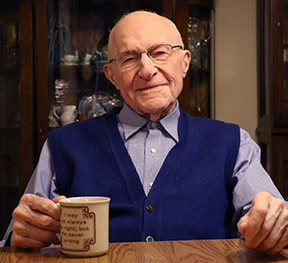
Art Stratman, MD, a retired family physician, enjoys playing a few games of
pool each week, and even finds time to mix in some Mexican Train dominoes. But, when his bilateral inguinal (groin) hernia flared up, the pain made routine activities difficult to enjoy.
“I had a left inguinal hernia repaired about 23 years ago, and a right one repaired about four years ago,” Dr. Stratman said. “Both recurred within the past year, and they were painful.”
Robotic Repair
He was referred to Patrick E. McGregor, MD, who recommended an outpatient, minimally invasive robotic procedure to repair the hernia. Dr. McGregor began performing hernia repairs robotically in March 2016. He
has performed 35 such surgeries in the past year and more than 200 robotic surgeries during his medical career.
“I had no pain and no problems. It was that simple.”
Robotic technology lets surgeons perform complex procedures through a few small incisions. A mini camera gives the surgeon a high-definition view inside the body. Tiny, flexible doctor controlled surgical instruments offer precision and control.
“Dr. Stratman was a good candidate for robotic repair because his hernia was recurrent and had already been repaired with the open approach,” Dr. McGregor explained. “Rather than going through the same scarred area from the front, I could access the hernia from behind the abdominal muscle.”
No Pain, No Problem
For Dr. Stratman, the biggest benefit of having robotic surgery was being pain-free after the procedure. “Dr. McGregor gave me a prescription for pain medicine, but I never had it filled because I had no pain,” he said. “I had no pain and no problems. It was that simple.”